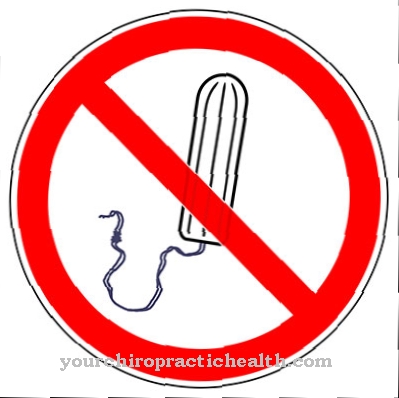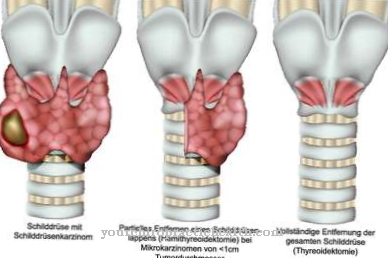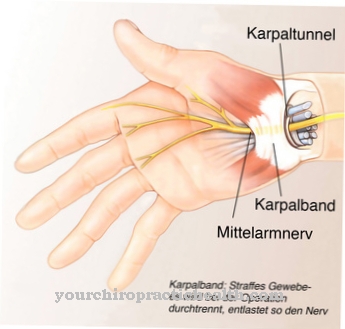If children have trouble coordinating movements, a Dyspraxia exist. This is a lifelong disorder in the learning of movement sequences. The causes cannot be treated, but targeted therapeutic measures can significantly improve the patient's gross and fine motor skills.
What is dyspraxia?

© Claudia Paulussen - stock.adobe.com
Dyspraxia is a lifelong coordination and developmental disorder, also known as Clumsy Child Syndrome referred to as. Around eight to ten percent of all children suffer from the disorder. Boys are more often affected than girls.
Dyspraxia patients have problems moving and acting in Bring harmony or cannot plan such actions in a goal-oriented manner. This prevents them from just doing what they want to do. Every task has to be thought through step by step in order to get from start to finish. For example, if a dyspractical child wants to tie their shoelaces, they must first know exactly what the shoelace looks like when it is tied.
causes
A planned and forward-looking action is just as necessary for every movement as the functioning motor skills. However, this does not work automatically with dyspractical children. On the contrary: you have to think about every move beforehand. The ability to plan movement sequences is clearly limited in them, which leads to motor difficulties.
The exact causes of the dyspraxia are not yet fully understood and need further investigation. What is certain is that they result from damage to the brain. The disorder may be a result of immature neuronal development. Often it is part of a continuum of related coordination and developmental disorders. For example, dyspraxia is often associated with autism, ADHD, Asperger's syndrome, dyslexia, or dyscalculia.
Symptoms, ailments & signs
Dyspraxia manifests itself in gross and fine motor disorders. Affected children find it difficult to learn and plan movements and actions. This means that you cannot save certain movement sequences and call them up again when necessary. They also have difficulty moving their arms and legs at the same time.
As a result, they have problems performing activities that children of the same age usually do. These include, for example, tying shoelaces, catching a ball or building a tower out of wooden blocks. Other symptoms are the slipping of facial features and the uncontrolled movement of individual limbs.
In school, dyspraxia often manifests itself in the form of a reading and spelling weakness. Numbers and letters are mixed up. 18 becomes 81, 6 becomes 9 or b becomes p. In addition, the affected children have problems holding the pen and writing something at the same time. There are also difficulties with shapes, lengths, sizes, directions and spatial relationships.
Diagnosis & course
Children diagnosed with dyspraxia lack the ability to learn movement sequences. They stand out due to uncoordinated hand gestures and movements. They also take a lot longer to learn certain things. These patients are often unable to cope with everyday tasks such as getting dressed in the morning. In addition, there is frequent teasing by classmates during school hours.
Dyspraxia patients are perceived by their classmates as less intelligent and slower. As a result, long-term bullying can have a profound effect on the child's psyche. In addition, depression can occur due to constant failure or lack of understanding in the social environment. Since dyspraxia is lifelong, early diagnosis is extremely significant. This is the only way to successfully improve the symptoms.
Complications
Because of the dyspraxia, there are complications in the movement of children. These are usually not learned properly. If the dyspraxia is not treated, life-threatening conditions can arise if the child cannot perform certain movements. The disorder can extremely restrict the child's everyday life.
As a rule, it is not possible to plan certain actions or to carry them out in a targeted manner. This leads to social difficulties and difficulty concentrating. Often the children cannot follow what is happening in school and cannot properly assess dangerous situations. Serious injuries can result. In some cases, uncontrolled movements also occur, which can lead to bullying.
In addition, everyday life is made more difficult due to poor reading and spelling. Likewise, shapes and lengths cannot be correctly identified and assigned, which greatly hinders learning success. The restricted motor skills also lead to discomfort when eating and drinking, so that the children are dependent on the help of other people. The treatment aims primarily at the complications that make everyday life difficult so that the patient can live alone in adulthood. However, this is not possible in all cases.
When should you go to the doctor?
Since the dyspraxia does not heal itself, a doctor must be consulted in any case. The earlier the disease is treated, the higher the likelihood of a positive course of the disease in the patient. As a rule, the doctor must be consulted if the person concerned has problems with coordination. An unsteady gait or difficulties with simple movements can also indicate dyspraxia and should be examined. Most of those affected also have problems with fine motor skills and gross motor skills, so that a doctor must be consulted with these complaints.
Early diagnosis is particularly important in children. Furthermore, complaints in reading and writing can indicate the dyspraxia, so that the child needs special support in his life. If those affected suffer from bullying or teasing, psychological support should be initiated. The diagnosis itself can be made by a pediatrician. However, further treatment is carried out with the help of various therapies by the respective specialists. The life expectancy of the patient is usually not affected by the dyspraxia.
Doctors & therapists in your area
Treatment & Therapy
If dyspraxia is suspected, the pediatrician responsible will first take an anamnesis of the child. In this way, somatic and neurological damage can be excluded. This is followed by an assessment of the patient's difficulties in coping with everyday life. The causes of dyspraxia cannot yet be treated.
Rather, parents of affected children can try to improve the gross and fine motor coordination of their offspring. Methods of occupational therapy, physiotherapy or motopedics can be used for this purpose. In therapy, children carry out specific movement sequences under guidance and thus find more security. Depending on the extent of the disease, speech therapy may also be necessary.
Targeted oral therapy can, for example, solve problems with eating and drinking. In addition, the parents of affected patients should ensure a continuous daily routine. Each day should be clearly structured and very similar to the previous one. Many children find it helpful when their parents prepare for the next day with them in the evening. For this they can, for example, prepare breakfast and choose clothes together.
In addition, parents must particularly encourage and support their child. This requires patience, advocacy, praise, understanding, and empathy. Together they should talk to the child about the disorder. This often leads to great relief on both sides. In contrast, inappropriate censure of the child often leads to serious self-doubt.
Outlook & forecast
According to the current scientific status, the dyspraxia is not considered curable. Since the causes of the disease cannot be fully clarified to this day, there is no therapeutic method that leads to a cure for the dyspraxia. Nevertheless, with a good and individual treatment plan, significant improvements in the patient's health can be achieved.
In physiotherapy and occupational therapy, the possibilities for movement sequences are specifically trained and improved. The person concerned learns how to cope with everyday life with the existing restrictions. However, some symptoms persist for life despite all efforts. Nevertheless, a good lifestyle is possible with the motor skills learned. Well-being depends on how the patient deals with the disease in everyday life. If the person concerned succeeds in adapting well to the dyspraxia, a full life becomes possible.
If there are other illnesses, the prognosis worsens. Particularly in the case of mental disorders or mental stress states, a downward trend in the motor skills learned can be seen. If the psyche stabilizes and the sick person lives in a caring and understanding environment, an alleviation of the symptoms can be seen. If self-doubts can be overcome and a fundamentally optimistic attitude towards life can be maintained, the symptoms will usually improve.
prevention
According to the current state of knowledge, there are some risk factors that favor dyspraxia. These include complications during pregnancy and childbirth, such as growth retardation of the unborn child, infections during pregnancy, low birth weight or premature birth. Accordingly, pregnant women should have a balanced diet and generally pay attention to a very healthy lifestyle.
Aftercare
The measures and options for follow-up care are usually very limited in dyspraxia. First and foremost, the person affected depends on a comprehensive examination, which should be carried out at an early stage. Only by diagnosing dyspraxia at an early stage can further complaints or disturbances in child development be prevented.
The earlier the disease is recognized, the better the further course is usually. For this reason, parents should consult a doctor at the first signs and symptoms of the disease in order to prevent the symptoms from worsening. The treatment of the dyspraxia usually takes place through therapy or through physiotherapy measures. There are no further complications.
Parents can repeat some of the exercises from these therapies with the child at home and thereby further alleviate the symptoms. Often, intensive therapy and care by the parents or other relatives is necessary. Intensive and loving conversations with the child are also very useful. Parents can also contact other people with dyspraxia, as this often leads to an exchange of information. As a rule, this disease does not reduce the child's life expectancy.
You can do that yourself
Dyspraxia is not curable, but the strongest motor abnormalities can be corrected with targeted support for the children concerned. However, the prerequisite for this is their active participation. This, in turn, can only be achieved by increasing their self-esteem. Often, however, the self-confidence of those affected is very limited, which then prevents a positive development of motor skills.
If the child takes longer to do their homework, always performs poorly in sport, has difficulties with spatial orientation or cannot coordinate their movements, it is therefore particularly important to give them consolation first. This creates the prerequisite for working with him to develop strategies on how performance can be improved.
Since information processing processes are different in people with dyspraxia than in most other people, other learning strategies for developing gross and fine motor skills must also be used. With the help of these strategies, a significant improvement in motor skills is possible.
Any improvement in performance should be rewarded with praise and advocacy, as this is the only way to stabilize it. In this context, constant blame and impatience would be counterproductive. Above all, you should talk to the child about their weaknesses, while at the same time giving them the feeling that they cannot help but improve.




.jpg)




















.jpg)

.jpg)
